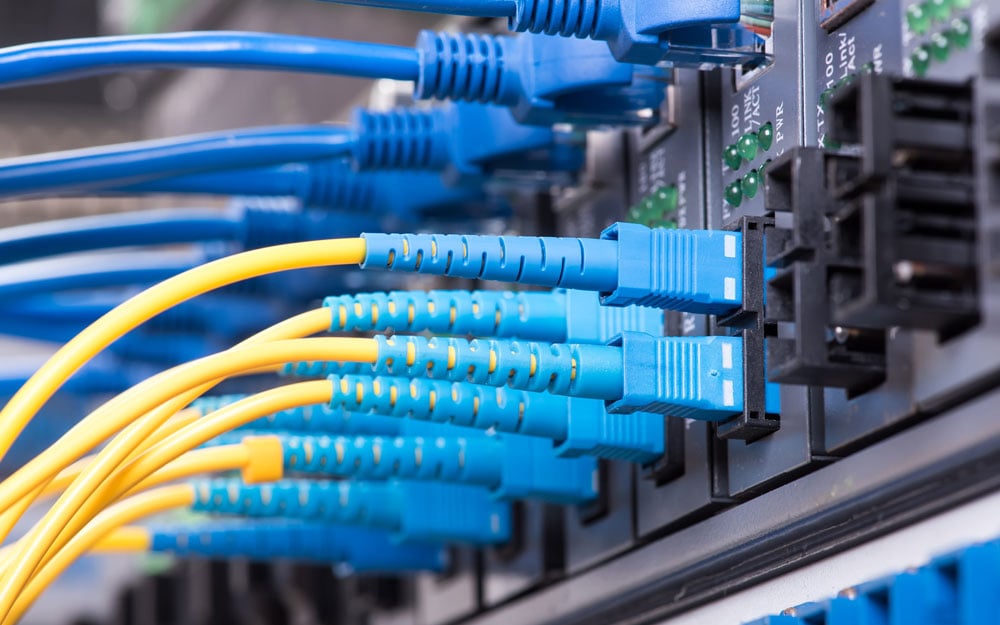

Fiber everywhere
The new reality for a futureproof infrastructure for 5G, IoT and beyond
What does fiber everywhere mean?
Networks are experiencing an explosion of new services with unpredictable needs, including an insatiable growth in bandwidth driven by broadband services, massive scaling expected for IoT and 5G devices, and mobile edge computing driven by latency concerns from critical services.
These are just a few of the factors driving growth in fiber everywhere and challenging the carrier’s ability to handle this new reality. Supporting this highly scalable and flexible infrastructure requires a different set of skills and processes.
With 100 G/bits and soon 400 G/bits becoming the norm, fiber is the only solution. Having a fiber network that’s ready for this and the skills to deploy new fiber quickly—without issue when there isn’t enough—will be essential to maintaining a competitive advantage.
Fiber-to-the-edge and mobile-to-the-end-user are no longer a dream, but a reality. Are you ready to embrace fiber everywhere?
EXFO has the solutions and expertise you need to take fiber everywhere.


Challenges
How will fiber everywhere impact carriers?
Today’s networks are evolving to address high-bandwidth, localized and intelligent services. A big part of this evolution is the shift away from copper or coax infrastructures towards fiber. Whether it’s fiber deep for next-gen cable MSOs, C-RAN to support 5G or simply modernization of residential broadband with FTTC, the shift to fiber is on. Having the right skills and tools will be critical for carrier operations and construction teams to ensure this transition goes as planned and their fiber network remains a competitive asset.
Managing large-scale fiber construction projects
Large-scale fiber installation projects, regardless of whether they’re data center builds or outside plant builds, are often plagued by issues like quality and deadlines for completion. And while some of these issues are unavoidable, many of them can be traced back to process. For projects involving thousands of fibers, manual fiber testing can become a very tedious and error-prone activity, and auditing test results is often done on a representative sample basis.
Manual fiber testing leads to errors or inconsistency in test setup and execution, which in turn leads to questionable results. Additionally, results are often captured, audited and approved more slowly. Issues with training or failure to follow standard methods can go undetected for the duration of the project, causing significant delay and impacting budgets.
The key to improving this activity is to have automated real-time testing that covers setup, execution, recording and auditing of results. This is the only way to track progress in real time, have 100% coverage of auditing test results and identify training or procedural issues before they impact the project.
Fiber characterization for 100G and beyond
Most of the fiber currently installed in data centers and outside plants was tested and characterized for 10 Gbit/s signals—which was considered high speed at the time. Now the same fiber plants are expected to carry 100 Gbit/s, and possibly 400 Gbit/s, which poses a problem in many cases. These higher-speed signals are more susceptible to fiber impairments such as reflectance and insertion loss, which may not have been noticeable at 10 Gbit/s—especially for intra-data center applications.
Insertion loss and optical return loss are typically measured with an optical loss test set (OLTS), while reflectance requires an optical time-domain reflectometer (OTDR). Though OTDR tests provide more detailed information (including reflectance), they typically take 15–35 seconds wheras an OLTS test can be done in under 5 seconds. In large fiber count situations, like a data center upgrade, this difference can mean days on an overall schedule.
Choosing the right tests is a matter of managing risk—i.e., thoroughness of testing versus time to complete.
Fiber deep deployment for MSOs
Fiber deep, along with other changes happening in the MSO access space, such as distributed access architecture (DAA) and remote PHY, will significantly change the technology landscape. Technicians, that are trained on traditional coax CMTS architectures will need to learn how to build, test and operate fiber rich, Ethernet deep architectures.
Fiber comes with its own set of challenges, especially as bandwidth limits get pushed higher to address broadband services. Impairments—such as damaged or dirty fiber connectors, cable macrobends, bad splices, and dispersion issues that become more prevalent for signals greater than 10 Gbit/s on fibers longer than 10 km—will impact network performance if not accounted for and dealt with. Additionally, fiber deep networks will start to leverage CWDM and DWDM technologies to make more effective use of the fiber infrastructure—especially as emerging services such as IoT, 5G and over-the-top streaming broadband become more common.
Having the right tools and solutions to address these issues up front will be critical to successful fiber deep transformations.
Fronthaul monitoring
Centralized radio access networks (C-RAN) have introduced a different architecture for connectivity between the radio head and the baseband unit (BBU). And though this architecture offers several advantages, such as power, space and cost savings at the antenna site and a centralized location for the BBUs, it also introduces additional testing complexity. The remote radio head (RRH) may be located up to 15 km from the BBU and this, combined with an increase in RRHs to address the anticipated density and bandwidth requirements of 5G, and even LTE-A, presents a significant monitoring challenge.
Given the increased number of RRHs, the distances over which they may be spread from the BBU and the fact that each technician will now be responsible for more RRHs, it is critical that the cost to maintain this fronthaul network be managed carefully.
Centralized (remote) test and monitoring of the fronthaul fiber plant, combined with the ability to analyze RF interferers will be critical to optimal network performance.

Solutions
How will carriers benefit from fiber everywhere?
Fiber everywhere is not going to change the way carriers do business. That role falls to the new service enabling technologies, like 5G, IoT and even NFV. But having fiber everywhere will make it easier to deploy these new services. Greater scalability and capacity, better signal quality over longer distances and a flatter network architecture provide a fertile platform for service innovation. Maximizing your current investment in fiber and deploying new fiber quickly and flawlessly requires a new level of skills, tools and insight.
Bandwidth scalability
If there’s one thing that certain about today’s network, it’s that you cannot predict what kind of services will be offered in the future. Carriers today need to be ready for massive scalability, both in terms of the bandwidth demanded by end users and applications, and in terms of the number of end user devices in the network.
This unpredictable growth places a large burden on the underlying infrastructure, which needs to scale accordingly, without requiring large construction projects or other such investments.
A well-built and properly characterized fiber network provides this flexible scalability. By having the right tools and processes to ensure the fiber infrastructure can operate as specified and is able to handle the wavelength counts and higher speeds being planned or deployed today, carriers will be in a much better position to address any unforeseen capacity expansions, quickly and without issue.
True competitive differentiation will come from being able to deliver tomorrow’s services on today’s network.
A better quality signal at a lower cost
Traditionally, much of the cable/ MSO distribution plants have used analog optical systems to distribute their RF signals. And while this technology served them well, especially when cable systems were primarily analog, today’s digital broadband services demand ever greater amounts of bandwidth, putting a significant strain on this architecture.
Most cable/ MSOs have started an aggressive rebuild of their access plants—a project often referred to as fiber deep. Essentially, the project involves two fundamental changes: First, the centralization of much of the active electronics into a data center environment, and second, a deeper penetration of fiber infrastructure, using lower cost, higher-bandwidth digital signals to better leverage this new fiber and bring increased bandwidth to the end user for advance broadband services.
The ability to deploy a high-quality fiber network and characterize the fiber to make sure it can deliver as promised will be critical to the success of fiber deep initiatives. Having the right test equipment and processes in place will be critical to an on-time, on-budget build out. Additionally, having the ability to monitor this fiber infrastructure on an ongoing basis will ensure flawless performance as broadband penetration continues.
Higher-speed access through FTTC
As the number of broadband services continues to expand and the bandwidth required by those services continues to increase, carriers are challenged to keep up with last-mile capacity demands. Traditional copper DSL solutions, like ADSL2+ and VDSL2 are reaching their capacity limit, which is greatly impacted by the length of the DSL copper loop.
The solution to this challenge, known as fiber-to-the-curb (FTTC), is to push fiber deeper into the network to shorten the loop as much as possible, specifically for deployments where fiber-to-the- home is cost prohibitive. Like the cable/ MSO fiber deep initiatives, FTTC leverages the reach and bandwidth advantages of fiber to shorten the copper loop to the point where tens or even hundreds of Mbit/s are possible.
Having the right tools and processes to deploy, test, characterize and monitor this fiber plant is critical to the success of FTTC initiatives.
Centralized equipment to simplify operations
Centralized radio access network (C-RAN) is a big part of the evolution towards 5G. With the expected increase in cell site density to address scaling in end-user devices and bandwidth, C-RAN becomes a key aspect of managing cost and maintenance.
By centralizing the BBU infrastructure and allowing the RRHs to be located up to 15 km away, the MNO can extract significant savings. Centralizing the BBU reduces space and power costs from the cell site, and locating it centrally, in a lower-cost facility, saves on real estate, power and cooling costs.
The challenge now is managing the fronthaul fiber network and diagnosing radio issues remotely—in order to reduce truck rolls and debug time.
Having the right tools, processes and technology to monitor and diagnose faults both in the fiber and RF infrastructures will be critical to extracting full value from the transition to C-RAN.
Solutions
The transformation to an all fiber network is an essential for today’s networks. Whether it’s converting the central office into a data center (CORD), replacing coax and analog fiber systems in the MSO access (fiber deep), evolving to a centralized RAN (C-RAN) architecture in preparation for 5G or upgrading existing fiber systems to 100G or 400G for more capacity, fiber will play a vital role. Having the right processes, skills and tools will ensure your transformation is successful. Are you ready?
Fronthaul testing
Transforming the RAN network into a centralized RAN (C-RAN) architecture is a critical aspect of the larger move to 5G, driven by the need to scale bandwidth to the radio head, reduce power and space requirements at the radio head and drive OPEX savings. By centrally locating the baseband units (BBUs) and feeding remote radio heads (RRHs) with fiber, MNOs can significantly improve operations efficiency. However, these savings are only half the battle. 5G will also bring a considerable increase in RRHs to deal with the anticipated bandwidth requirements of 5G applications. This will, in turn, increase RF interference issues, which can be very time consuming and expensive to isolate.
Having a fronthaul monitoring solution that covers both the fiber infrastructure and the CPRI signals in the fronthaul, to identify and isolate RF interferers, will be critical to operations efficiency. Being able to remotely identify RF issues, including which specific RRH is impacted, will save technicians significant time by eliminating unnecessary truck rolls.
EXFO has the fronthaul monitoring solutions you need to gain 100% visibility and optimize operations.
Test automation
As carriers continue to transform their networks to address everything from streaming broadband content to IoT to 5G and more, they are also required to deploy the necessary fiber infrastructure to support this demand. With construction projects regularly deploying thousands of fibers at a time, getting the job done in a timely manner and with 100% visibility into the quality of the installation is a concern. Knowing that every fiber has been tested and characterized properly and that issues are identified early and flagged appropriately for follow up is critical to both the carrier’s service goals and, in the case of installation contractors, getting paid quickly.
Having a test automation solution that can configure test setups, upload results, ensure 100% compliance with test methods, provide complete visibility to schedule progress and analyze the results to validate 100% of all fibers will be essential to any future construction project. Additionally, analytics from the test results can be used to inform training programs and identify poor contractor performance.
As the leader in fiber testing solutions, EXFO has the test automation solutions you need to take control of your fiber construction projects.
Fiber characterization
Every day, thousands of miles of new fiber are installed in networks throughout the world in anticipation of an explosive growth in bandwidth and to drive fiber closer to the end user. But what about the fiber already installed? Can this infrastructure support signaling rates beyond 10 Gbit/s?
Characterizing fiber in data centers, central offices and outside plants for 100 Gbit/s or eventually 400 Gbit/s is more complicated than for 10 Gbit/s, which was considered high speed when deployed. It takes more than a light source and power meter (LSPM) to guarantee that these higher-speed signals can be carried flawlessly. Given that an OTDR can significantly extend the amount of time needed to test, balancing OTDR usage with LSPMs will help you remain on schedule while minimizing risks.
EXFO has the experience, solutions and products—including our industry-leading intelligent Optical Link Mapper (iOLM)—you need to fully characterize any fiber upgrade project with complete confidence.
Fiber inspection
The leading cause of fiber-optic signal quality issues within the data center or outside plant is contaminated or damaged connector endfaces. In fact, a recent NTT Advanced Technology study reported that well over 80 percent of issues were due to contamination, followed by damaged ferrule endfaces. 100 percent inspection of all fiber connectors is necessary to fully characterize new builds and rehabilitation projects.
Today’s networks further complicate this issue by leveraging multifiber push-on (MPO) connectors which can pack 12, 24 or even 32 fibers into a single connector not much bigger than a standard single-fiber connector. With fiber spacing in the order of 250 nm, inspecting each fiber individually becomes a challenge, especially with legacy inspection solutions that use manual adjustments.
EXFO’s fully automated fiber inspection solution includes specialized nozzles for MPO and LC connectors, meaning the same tool can inspect either configuration. And with automatic, fully indexed scanning of every fiber in the connector, testing an MPO is quick and easy, leading to 100 percent coverage of all fiber connectors in projects of any size.
Resources
All resourcesLanguage
Resource type
